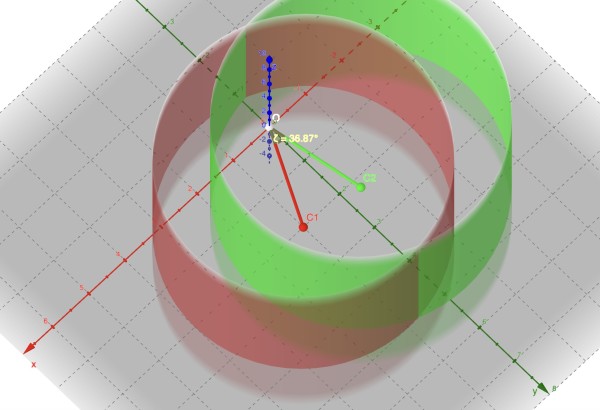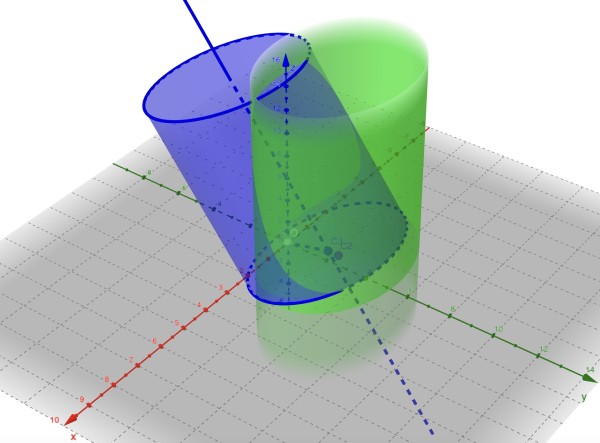A vertical cylinder (of infinite length) is just the 2D equation of a circle (x-x0)2+(y-y0)2=R2 where its central axis passes through (x,y,z)=(x0,y0,0) in 3D, its central axis is parallel to the z-axis, and R is its radius. Therefore a cylinder in 3D is some form of transformation so that the vertical axis is no longer vertical, but is aligned with a vector (a line in parameterised form).
Other equations of a cylinder are (x-x0)2+(z-z0)2=R2 where the central axis (parallel to the y-axis) passes through (x0,0,z0);
and (y-y0)2+(z-z0)2=R2 where the central axis (parallel to the x-axis) passes through (0,y0,z0).
All these cylinders have infinite length and the only way to restrict the length is to define boundaries. In the case for (x-x0)2+(y-y0)2=R2 the boundaries are governed by the range of z values: z∈[low,high]; or low≤z≤high, the length being L=high minus low.
We're now going to consider rotating the cylinder (x-x0)2+(y-y0)2=R2. If the vertical axis is the z-axis, then rotating about this axis only moves the centre (x0,y0). The circular cross-section is unaffected so only x0 and y0 are going to change.
The easiest way to see what the new coordinates will be is to revert temporarily to polar coordinates (r,θ): x=rcosθ, y=rsinθ. Note that x2+y2=r2 and tanθ=y/x. In the polar reference frame, r=OP where O is the origin, r=R is the polar equation of a circle radius R, and P is any point on its circumference.
We're only interested in (x,y)=(x0,y0) so x0=rcosθ, y0=rsinθ. The angle of rotation we'll call ζ (zeta).
rcos(θ+ζ)=rcosθcosζ-rsinθsinζ=x0cosζ-y0sinζ, rsin(θ+ζ)=rsinθcosζ+rcosθsinζ=y0cosζ+x0sinζ.
The equation of the cylinder now becomes (x-x0cosζ+y0sinζ)2+(y-y0cosζ-x0sinζ)2=R2 in the x-y plane. But in the X-Y plane the equation of the cylinder will be:
(X-x0)2+(Y-y0)2=R2, because the X-axis has become the line y=xtanζ and the Y-axis has become y=-xcotζ in the x-y plane. The relation of the displaced centre to the X and Y axes is the same as the original position of the centre to the x and y axes. In other words, we can express the transformation of any point P(x,y)→P(X,Y) in relation to a new Cartesian frame of reference X-Y using a transformation matrix T=
⎛ cosζ sinζ ⎞
⎝ -sinζ cosζ ⎠
( X Y )=( x y )T.
Since there's no change to z T can be changed to 3D: T=
⎛ cosζ sinζ 0 ⎞
⎜-sinζ cosζ 0 ⎟
⎝ 0 0 1 ⎠
so that ( X Y Z )=( x y z )T. The inverse of T is T-1=
⎛ cosζ -sinζ 0 ⎞
⎜ sinζ cosζ 0 ⎟
⎝ 0 0 1 ⎠
which is useful in reversing the transformation process (X-Y→x-y).
The next step is to rotate the cylinder about the X or Y axis. This process will establish the direction vector of the cylinder. Consider rotating the cylinder about the X-axis. An observer looking along the X-axis will see the Y-Z plane with the X-axis represented as superimposed on the Y-Z plane's origin.
The cylinder will appear as a rectangle, length (height) L and width 2R. The Y-coordinate of the inner wall of the cylinder is Y=y0-R and of the leading wall it's Y=y0+R, cylindrical axis being Y=Y0. The cylinder is standing on the X-Y plane so the locations of the vertices of the rectangle (as viewed along the X-axis) are: (Y,Z)=(y0-R,0), (y0-R,L), (y0+R,L), (y0+R,0). Remember that we're using y0 wrt to the Y-Z plane (not the y-z plane). y0 is x0cosζ-y0sinζ in the original 3D plane (x, y, z axes).
If we take any point Q(Y,Z) and convert to polar coordinates Y=rcosφ, Z=rsinφ, tanφ=Z/Y. Rotation of Q through an angle ψ (psi) gives us:
Y'=rcos(φ+ψ)=rcosφcosψ-rsinφsinψ=Ycosψ-Zsinψ;
Z'=rsin(φ+ψ)=rsinφcosψ+rcosφsinψ=Zcosψ+Ysinψ in the Y-Z plane. The Y and Z axes are rotated to become Y' and Z' axes.
(Y,Z)→(Ycosψ-Zsinψ,Zcosψ+Ysinψ) as measured in the Y-Z plane. Relative to the Y'-Z' plane, though, the cylinder from this side point of view will still appear to be the same rectangle as in the X-Z plane, with central axis y0 from the origin.
The central axis of the cylinder has endpoints F(y0,0) and G(y0,L) which transform to:
F(y0cosψ,y0sinψ) and G(y0cosψ-Lsinψ,Lcosψ+y0sinψ) after rotation wrt to the Y-Z plane.
Slope=-Lcosψ/Lsinψ=-cotψ;
Z-y0sinψ=-cotψ(Y-y0cosψ)=-Ycotψ+y0cosψcotψ,
Z=-Ycotψ+y0cos2ψ/sinψ+y0sinψ=-Ycotψ+y0cscψ.
The X-coordinate is not affected by the rotation round the X-axis.
This is the Cartesian line equation of the central axis of the cylinder in the Y-Z plane. To convert to the x-y plane requires back substitution. The final result should involve only the angles ζ and ψ in addition to the variables x, y, z.
The first picture below shows the first transformation of a section of an infinite cylinder (red), centre C1(1,2,0), radius 3, rotated through an angle of ζ=tan-1(0.75) (approx 36.87°) to the position of the green cylinder, centre C2(-0.4,2.2). The z-axis (blue) is the axis of rotation. The x-axis is red and the y-axis green. The grid is the x-y plane. O is the origin. The centres C1 and C2 are intersections of the cylinder's central axis with the x-y plane. Although not shown, the X axis is the x-axis rotated anticlockwise through angle ζ, similarly, the Y-axis. This preserves the relative position of C2 wrt X and Y to be the same as C1 wrt x and y.

Pictures courtesy of GeoGebra Calculator Suite
Below shows the second transformation of rotation about the x-axis, a tilt of tan-1(5/12) degrees (22.62°) from the vertical anticlockwise. The red cylinder has been omitted, showing the transition from the green to the blue only. The central axis of the blue cylinder is shown, together with its centre C3 (centre of tilted base). C2 is also shown but it's quite faint.
The line equation for the direction vector of the central axis is (-0.04,132/65,11/13)+λ(0,-5,12) and the cylinder's length is 13 units=√(02+(-5)2+122)=13. Note that the x component hasn't changed (from its value -0.04 in the green cylinder, the first transformation). 132/65=y0cosψ (y0 wrt Y-Z plane=x0cosζ-y0sinζ wrt to original 3D reference frame), 11/13=y0sinψ. λ=0 determines the position of C3 in the original frame; λ=1 determines the position of the centre of the top of the cylinder.

This example is intended to illustrate the process of transformation from the simple equation of a cylinder to its representation after rotating and tilting. By backtracking from this representation (reversing the transformation in two stages) the original equation of the cylinder can be derived.